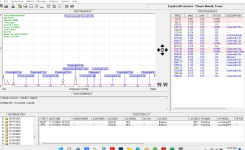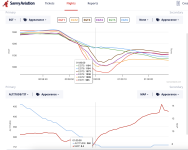Hi Everyone,
On my 3 yr old RV-10 I've been struggling to find the cause of a really weird vibration that comes on with higher power settings. It makes the control stick vibrate and I can feel it in the bottom of the seat and on the floor. After balancing the prop, changing engine mounts, and doing just about everything else I could think of, the folks over at Van's let me come over and do a full spectrum analysis. During the run up we found typical vibration orders for a 6 cylinder with a 3 bladed prop, but we also found that as the RPM was advanced past about 2000 (about when the mp starts going up) an off the chart 2.5 order vibration showed up. I wasn't crazy after all!
So the question is, what could be causing this and what steps could I follow to troubleshoot? From my research online and after speaking with a few people, it seems that I may have some sort of torsional vibration that's being cause by cylinder imbalances which, according to one expert, is most likely induction based. It's not just one cylinder, or it would show up as a .3 order vibration (I believe). The prop is balanced to .05 ips by the way. I've inspected the intake system to include checking for leaks, checking intake valve lift and intake dry tappet valve clearance, and inspecting the hydraulic lifters. All seem normal. I'm running EFII electronic injection and I've flown with the injectors electronically balanced to all peak at within .3 gph and also let them run uncorrected, which is a "gami spread" of about 1.0 gph. It didn't seem to make any difference.
Any ideas? I've found a bunch of vibration discussions within this forum over the years but I've never found one with a 2.5 order. I'm attaching the analysis we did at 2300 RPM.
Engine Specs:
Barrett Precision Engines IO-540 narrow deck with cold air induction: 300 hours since rebuild
9-1 cylinders, Fly EFII System 32 ignition and injection
Whirlwind HRT 374 3-blade prop
Thanks!
On my 3 yr old RV-10 I've been struggling to find the cause of a really weird vibration that comes on with higher power settings. It makes the control stick vibrate and I can feel it in the bottom of the seat and on the floor. After balancing the prop, changing engine mounts, and doing just about everything else I could think of, the folks over at Van's let me come over and do a full spectrum analysis. During the run up we found typical vibration orders for a 6 cylinder with a 3 bladed prop, but we also found that as the RPM was advanced past about 2000 (about when the mp starts going up) an off the chart 2.5 order vibration showed up. I wasn't crazy after all!
So the question is, what could be causing this and what steps could I follow to troubleshoot? From my research online and after speaking with a few people, it seems that I may have some sort of torsional vibration that's being cause by cylinder imbalances which, according to one expert, is most likely induction based. It's not just one cylinder, or it would show up as a .3 order vibration (I believe). The prop is balanced to .05 ips by the way. I've inspected the intake system to include checking for leaks, checking intake valve lift and intake dry tappet valve clearance, and inspecting the hydraulic lifters. All seem normal. I'm running EFII electronic injection and I've flown with the injectors electronically balanced to all peak at within .3 gph and also let them run uncorrected, which is a "gami spread" of about 1.0 gph. It didn't seem to make any difference.
Any ideas? I've found a bunch of vibration discussions within this forum over the years but I've never found one with a 2.5 order. I'm attaching the analysis we did at 2300 RPM.
Engine Specs:
Barrett Precision Engines IO-540 narrow deck with cold air induction: 300 hours since rebuild
9-1 cylinders, Fly EFII System 32 ignition and injection
Whirlwind HRT 374 3-blade prop
Thanks!







